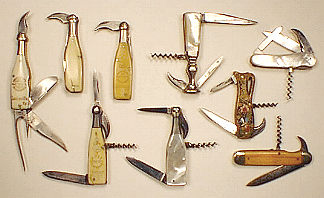The Korn's Patent Mystery


On February 8, 1883 George W. Korn of New York was granted German patent number 21125 for his "Korkenzieher." On August 28, 1883 Korn received U. S. Patent Number 283,900 entitled "Cork Turner."
The Patent Drawing shows the blade on the bottom of the bottle shape knife at left above. The "cork turner" blade is marked KORN'S PATENT. The knife blades are marked HENRY SEARS & SON 1865 (the year founded). The foil cutter is marked REGISTERED. The knife to its top right is the same with the blades closed. To use it, the long prong is carefully slipped in beside the cork until penetrated by the short prong. Four serrations on the long prong just below the point on the short prong engage the cork. A twist to break the cork free from the bottle wall and a long, slow pull will nicely draw out the cork.
The next two knives have the same advertising as the cork turner: "Compliments of National Tobacco Works, Louisville, Ky." These two, however, have corkscrews which are released by pressing down on the foil cutter blade. The knife blades and foil cutter are marked HENRY SEARS & SON 1865. In addition, the foil cutter has the same KORN'S PATENT mark as the cork turner type. This mechanism is not shown in the Korn's Patent.
The extraordinary wine goblet with mother of pearl scales has the corkscrew mechanism and all blades are marked Novelty Cutlery Co. The bottle with mother of pearl scales has the SEARS markings and the KORN'S PATENT mark on the foil cutter. The knife blades of the Urn are marked Cattaraugus Cut. Co. and the foil cutter is marked REGISTERED like the cork turner.
The knife on the top right has one blade marked D.R. PATENT 14392. This is a German patent of December 31, 1880 issued to Bierhoff & Wever of Solingen. The worm is raised from its compartment by depressing the lever on the back of it thus operating in a similar fashion to the foil cutters described above.
The master blade of the knife at bottom right is marked HALLSTROM ESKILSTUNA (Sweden). Depressing the foil cutter raises the cork in the same manner as the bottle foil cutters.
So why are some of the bottles marked KORN'S PATENT when they don't appear to be Korn's Patent at all? All of the knifes with corkscrews in the photo appear to be more like the Bierhoff & Wever patent than the Korn's.
My guess? The manufacturers of the Korn's Patent realized that it was a rather impractical, cumbersome method of pulling a cork. The Bierhoff & Wever concept was better and the bottles were changed to use this method. Leftover foil cutters with the Korn's Patent mark were used in the manufacture even though the knives produced were not that patent.
To see how the Korn's Patent works go to Korn's Patent.
©1998 Donald A. Bull